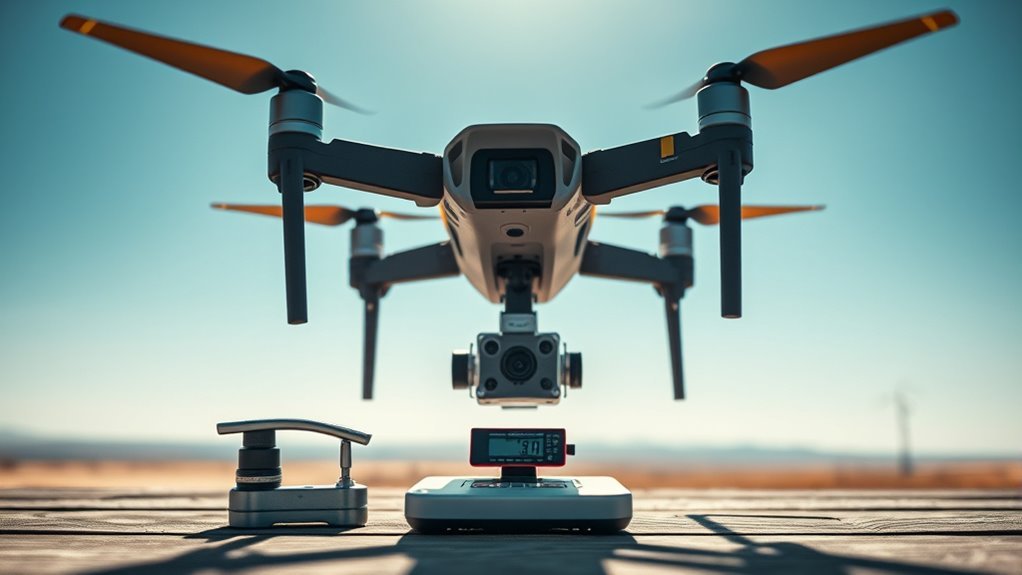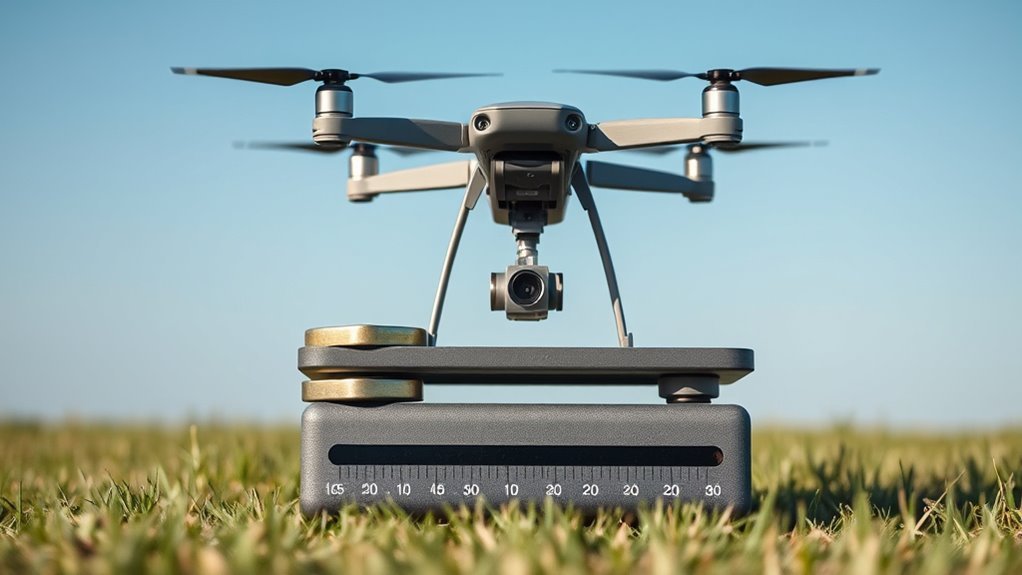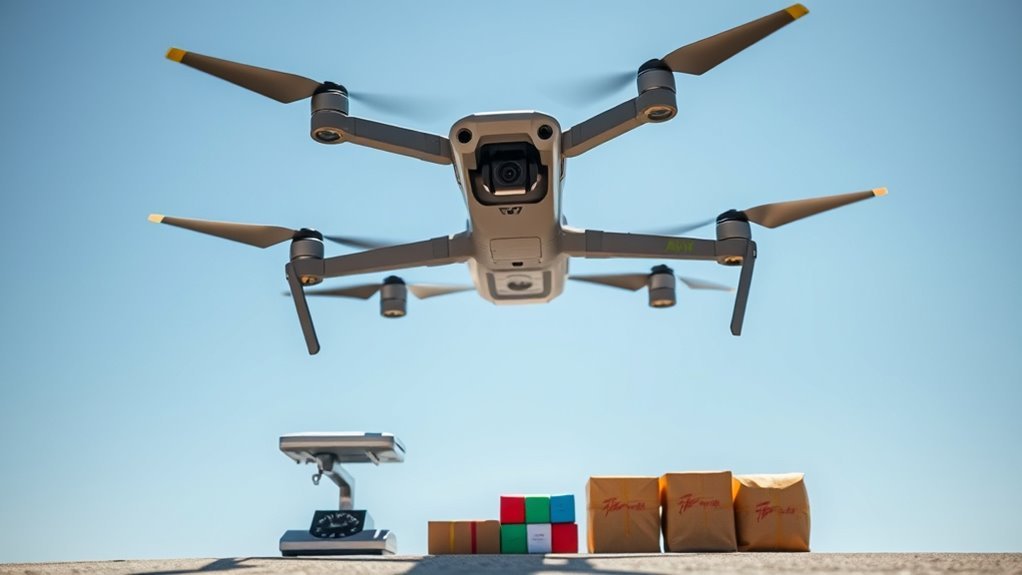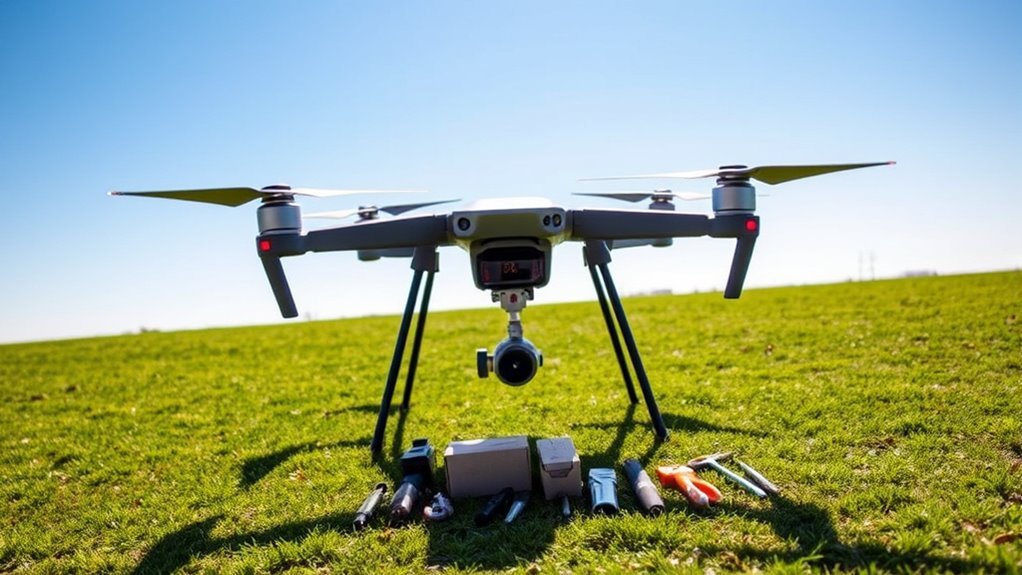The factors determining how much a drone can carry are its design, motor strength, battery efficiency, weight distribution, and regulatory guidelines. A drone’s structure influences its aerodynamic efficiency and payload capacity. Strong, efficient motors enhance lift without excessive weight, while battery capacity affects flight duration. Proper weight distribution guarantees stability during flight. Furthermore, adhering to regulations regarding maximum payload limits is essential for legal operation. Exploring these aspects will reveal more about optimizing a drone’s capabilities.
Drone Design and Structure

The backbone of a drone’s payload capacity lies in its design and structure. To maximize your drone’s potential, you’ll need to focus on aerodynamic efficiency and material selection. Aerodynamic efficiency minimizes drag, allowing for smoother flight and increased lift. By optimizing the shape of the drone, you can enhance its ability to carry heavier loads without compromising performance.
Material selection is equally critical; lightweight yet strong materials like carbon fiber or advanced composites provide the necessary strength while keeping the overall weight down. This balance is essential for maintaining stability during flight and ensuring that the drone can handle the intended payload. Additionally, using high-grade composites ensures resistance to environmental wear, which is vital for long-term durability. Ultimately, understanding these design principles empowers you to create a drone capable of achieving its maximum payload capacity. Additionally, considering drone battery life is crucial, as it directly impacts how much weight the drone can effectively manage during flight.
Motor Strength and Efficiency

After establishing a solid foundation with design and structure, the next key consideration is motor strength and efficiency. Your drone’s ability to carry payloads hinges on motor torque and thrust generation. High motor torque is essential for lifting heavier loads, as it directly influences the rotor’s capability to turn against gravitational forces. Efficient motors not only enhance thrust generation but also optimize energy consumption, allowing for longer flight times while carrying substantial payloads. When selecting motors, consider their power-to-weight ratio; stronger motors can provide more lift without adding excessive weight. Ultimately, balancing motor strength with efficiency guarantees your drone can achieve its full potential, granting you the freedom to explore various applications and payloads. Additionally, understanding motor torque and propeller thrust is crucial for maximizing lifting capabilities and ensuring stable flight with heavier payloads. Furthermore, the drone’s flight time can be significantly impacted by the weight it carries, influencing both performance and battery efficiency.
Battery Life and Power Management

While optimizing motor strength is essential for lifting payloads, battery life and power management play equally important roles in determining a drone’s overall performance. Understanding battery technology is vital, as it directly impacts how effectively you can use your drone. Power optimization strategies can enhance both flight time and efficiency, allowing you to explore more freely.
Here are four key factors to evaluate:
- Battery Capacity: Higher capacity means longer flight times.
- Weight Distribution: Proper weight management can prevent premature battery drain.
- Flight Conditions: Wind and temperature can affect battery performance.
- Smart Power Management: Utilizing software to monitor and adapt power use can extend your drone’s operational capabilities. Additionally, D22’s 3000mAh battery ensures dependable endurance for prolonged aerial adventures.
Payload Capacity Specifications
Payload capacity specifications are vital for determining how much weight a drone can effectively carry during flight. These specifications are derived from meticulous payload evaluations and capacity testing, ensuring that your drone remains efficient and functional under various conditions. Here’s a concise overview of key specifications to take into account:
| Specification | Description | Importance |
|---|---|---|
| Maximum Payload Weight | The total weight a drone can carry | Critical for safety and efficiency |
| Flight Duration | Time a drone can fly with payload | Impacts operational range |
| Load Distribution | Placement of weight on the drone | Affects stability and performance |
Understanding these specifications helps you make informed decisions about your drone’s operational capabilities, ensuring freedom in your aerial endeavors. Additionally, optimized battery systems play a crucial role in extending flight duration when carrying heavy payloads. With advanced battery optimization techniques, drones can manage power consumption efficiently, allowing for longer flights even with significant payloads.
Weight Distribution and Balance
When considering weight distribution and balance, you must assess the center of gravity, as it greatly influences stability and maneuverability. The strategy for load placement can enhance efficiency, ensuring that the drone remains level during flight. Additionally, the frame design plays an essential role in supporting ideal weight distribution, affecting overall payload capacity.
Center of Gravity
Understanding the center of gravity is essential for optimizing a drone’s payload capacity, as it directly influences stability and maneuverability. When you make center of gravity adjustments, you’re not just altering weight; you’re affecting how your drone performs in the air. Here are some critical center of gravity effects to evaluate:
- Flight Stability: A well-balanced drone responds better to controls, enhancing your flying experience.
- Payload Capacity: Optimizing balance allows for carrying more weight without compromising performance.
- Maneuverability: A correctly positioned center of gravity enables agile movements, giving you freedom in flight.
- Safety: Proper balance reduces the risk of crashes, ensuring your drone—and your investment—stays intact.
Load Placement Strategy
To maximize a drone’s performance, strategically placing the load is crucial, as improper weight distribution can lead to instability and decreased efficiency. You should focus on ideal load positioning, guaranteeing that the center of gravity remains within acceptable limits. Employing load stabilization techniques, such as securing the payload tightly and distributing weight evenly across the drone’s frame, can greatly enhance flight stability. For example, placing heavier items closer to the drone’s center helps maintain balance and improves maneuverability. Additionally, consider the drone’s flight path; if it’s likely to experience sharp turns or altitude changes, adjust the load accordingly. By prioritizing these strategies, you’ll guarantee your drone operates at its best, achieving the freedom of flight you desire.
Frame Design Impact
The frame design of a drone greatly influences its weight distribution and balance, directly affecting its payload capacity and flight performance. Properly designed frames enhance aerodynamic efficiency, allowing for greater freedom in flight. Here are four key considerations:
- Frame Materials: Lightweight yet strong materials like carbon fiber can greatly improve load capacity.
- Weight Distribution: An even distribution of weight prevents instability and maximizes control.
- Balance: Proper balancing guarantees efficient energy use, extending flight time.
- Design Geometry: Aerodynamically shaped frames reduce drag and improve overall performance.
Environmental Factors
While various factors influence a drone’s payload capacity, environmental conditions play a crucial role in determining how much weight a drone can effectively carry. Weather conditions like wind speed and temperature can greatly impact lift and battery performance. Additionally, the terrain type dictates stability; uneven surfaces may increase the risk of accidents.
Here’s a table summarizing these environmental factors:
| Factor | Impact on Payload | Considerations |
|---|---|---|
| Wind Speed | Decreases lift capacity | Strong winds require lighter loads |
| Temperature | Affects battery efficiency | Cold weather reduces battery life |
| Terrain Type | Influences stability | Rough terrain can destabilize a drone |
| Humidity | Impacts motor performance | High humidity can affect electronics |
| Altitude | Lowers air density | Higher altitudes reduce lift |
Regulatory Limitations and Guidelines
When operating drones, you must consider weight restrictions imposed by regulatory bodies, which can greatly impact your payload capacity. Compliance with certification standards is essential to guarantee safe and legal operation. Understanding these guidelines will help you optimize your drone’s performance while adhering to legal requirements.
Weight Restrictions by Law
Understanding weight restrictions by law is crucial for anyone involved in drone operations, as these regulations directly influence payload capacity. Ignoring legal implications can lead to severe consequences, and it’s important to be aware of the following aviation regulations:
- Maximum Takeoff Weight (MTOW): Each drone has a specified MTOW that must not be exceeded.
- Commercial vs. Recreational Use: Different weight limits apply depending on your operational purpose.
- Restricted Areas: Certain zones have stricter weight regulations to guarantee safety.
- Pilot Certification: Operating heavier drones often requires specific pilot certifications.
Certification and Compliance Standards
Certification and compliance standards play a pivotal role in determining a drone’s payload capacity, as they guarantee operators adhere to safety and operational guidelines. Steering through the certification processes can be complex, yet understanding these requirements is vital for maximizing your drone’s efficiency. Compliance regulations often outline specific weight limits, materials, and operational environments, which can directly impact your payload capabilities. By confirming your drone meets these standards, you not only enhance safety but also expand operational freedom. In addition, staying informed about evolving regulations can help you adapt your payload strategies effectively. Ultimately, while the quest for increased payload capacity is significant, it must align with the necessary certification and compliance to guarantee both legal operation and safety in the skies.
Frequently Asked Questions
How Does Drone Material Affect Overall Payload Capacity?
The materials used in drone construction considerably influence payload capacity. Lightweight materials enhance weight distribution, allowing for greater cargo loads. Conversely, heavier materials reduce capacity, limiting your drone’s efficiency and operational freedom.
Can Weather Conditions Impact Drone Carrying Ability?
Yes, weather conditions can greatly impact a drone’s carrying ability. Wind resistance can reduce stability and payload efficiency, while temperature effects may alter battery performance, affecting overall flight duration and capacity to transport heavier loads.
What Role Does Drone Size Play in Payload Limits?
You might think size doesn’t matter, but with drones, it really does. Drone dimensions dictate weight distribution, directly impacting how much payload they can handle, ultimately influencing performance and efficiency in various tasks you want to accomplish.
Are There Industry-Specific Guidelines for Drone Payloads?
Yes, there’re industry-specific guidelines that dictate drone regulations and payload standards. These standards guarantee safety and compliance while allowing you to maximize your drone’s capabilities based on its intended use and operational environment.
How Do Modifications Affect a Drone’s Carrying Capacity?
Modifying a drone’s structure is like tuning a high-performance car; performance upgrades enhance capability. However, improper weight distribution can hinder flight. Balancing modifications guarantees you maximize capacity while maintaining stability and control for ultimate freedom in flight.

